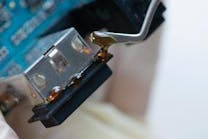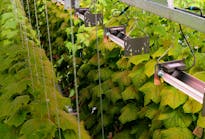What to look for when you are choosing LED grow lights
It is not surprised at how hard it can be to compare lights, even when using supposedly objective metrics. We learned so much that we decided to pass along some practical tips you can use when shopping for an LED grow light.
The Wavelength Output
No matter what type of grow lights you will be using, you need to understand the wavelength output and the way it can be measured and analyzed. However, choosing and buying a LED grow light based on PAR alone is not the best idea.
What Is PAR (Photosynthetically Active Radiation)?
PAR or Photosynthetically Active Radiation denotes the usable light that the plants will absorb. The rest of the light emitted will be reflected from the plants. Thus, the PAR does not measure all the light coming from the source, but the wavelengths the plants will use is perhaps the most important metric when buying an LED grow light, though it could be misleading.
How To Measure And Understand PAR Values?
Usually, PAR is measured with PPF (Photosynthetic Photon Flux) or PAR meter, which will show how many photons of light per second will make contact with the plant. What you need to know, however, is that PAR values of a light vary depending on the height at which they are measured. Be wary if an LED manufacturer does not report the height at which they measure PAR value. Better yet, look for charts that report PAR values at various heights and use the information for your comparison. Advanced LED’s PAR values chart is here.
The Higher The PAR, The Better The LED Grow Light
The Watts Drawn
Watts drawn is another measurement frequently cited by LED light companies.
What Do Watts Measure In LED Grow Lights?
Watts drawn measures energy consumption, not output. They tell us how much energy a light requires. Some LED light companies would like to make you believe that the two metrics are one and the same, but this is not true.
How To Understand Wattage And Its Correlation To Efficiency
If the efficiency and the output of the lights are not determined by the wattage, then how are they determined? Starting with the quality of the components and materials and going through the actual design (fans, heat sinks, chip density). There could even exist a reverse correlation and the lights that require more watts could be less efficient. In other words, if a LED grow light company is boasting about its wattage, you need to keep in mind this might be misleading and you should possibly research further.
Advanced LED Companies Offer Products That Reduce Energy Consumption, While Improving Performance
Innovative LED companies are using high quality LEDs, advanced lenses and are re-engineering their products to reduce energy consumption while improving performance. For example, Advanced LED’s ARC Series 2.0 draws 16% less energy simply because it has no internal fan. That is close to 20% reduction in electricity usage with zero reduction in performance. This is evident in our ARC 900 which includes sixteen 180 watt cobs (2,880 watts total output), while drawing a mere 780 watts of power. By way of comparison, a competitor’s light includes 2,100 watts of LEDs but draws a whopping 1,050 watts. Even worse, the light is priced higher than Advanced LED’s ARC 900.
The Quality Of The Components
The quality of the components used in LED grow lights manufacturing is a third consideration when buying such a light.
High Quality LED Chipsets
The production of high quality diodes is not very cheap, as each product must answer a set of specific requirements and emit absolutely correct wavelengths, while operating well over time. Good LED chipsets with diodes that meet these criteria are produced by certain reputable manufacturers only. That is why it is crucial to look for name brand chipsets (Advanced LED uses Cree brand) and LEDs that are made in America. Why? These components have been laboratory tested and are proven to outperform and outlast. We’ve all had the experience of purchasing an inexpensive no-name product that seems to work great for a few weeks and then burns out. High quality LED chipsets are no different.
It is not surprised at how hard it can be to compare lights, even when using supposedly objective metrics. We learned so much that we decided to pass along some practical tips you can use when shopping for an LED grow light.
The Wavelength Output
No matter what type of grow lights you will be using, you need to understand the wavelength output and the way it can be measured and analyzed. However, choosing and buying a LED grow light based on PAR alone is not the best idea.
What Is PAR (Photosynthetically Active Radiation)?
PAR or Photosynthetically Active Radiation denotes the usable light that the plants will absorb. The rest of the light emitted will be reflected from the plants. Thus, the PAR does not measure all the light coming from the source, but the wavelengths the plants will use is perhaps the most important metric when buying an LED grow light, though it could be misleading.
How To Measure And Understand PAR Values?
Usually, PAR is measured with PPF (Photosynthetic Photon Flux) or PAR meter, which will show how many photons of light per second will make contact with the plant. What you need to know, however, is that PAR values of a light vary depending on the height at which they are measured. Be wary if an LED manufacturer does not report the height at which they measure PAR value. Better yet, look for charts that report PAR values at various heights and use the information for your comparison. Advanced LED’s PAR values chart is here.
The Higher The PAR, The Better The LED Grow Light
The Watts Drawn
Watts drawn is another measurement frequently cited by LED light companies.
What Do Watts Measure In LED Grow Lights?
Watts drawn measures energy consumption, not output. They tell us how much energy a light requires. Some LED light companies would like to make you believe that the two metrics are one and the same, but this is not true.
How To Understand Wattage And Its Correlation To Efficiency
If the efficiency and the output of the lights are not determined by the wattage, then how are they determined? Starting with the quality of the components and materials and going through the actual design (fans, heat sinks, chip density). There could even exist a reverse correlation and the lights that require more watts could be less efficient. In other words, if a LED grow light company is boasting about its wattage, you need to keep in mind this might be misleading and you should possibly research further.
Advanced LED Companies Offer Products That Reduce Energy Consumption, While Improving Performance
Innovative LED companies are using high quality LEDs, advanced lenses and are re-engineering their products to reduce energy consumption while improving performance. For example, Advanced LED’s ARC Series 2.0 draws 16% less energy simply because it has no internal fan. That is close to 20% reduction in electricity usage with zero reduction in performance. This is evident in our ARC 900 which includes sixteen 180 watt cobs (2,880 watts total output), while drawing a mere 780 watts of power. By way of comparison, a competitor’s light includes 2,100 watts of LEDs but draws a whopping 1,050 watts. Even worse, the light is priced higher than Advanced LED’s ARC 900.
The Quality Of The Components
The quality of the components used in LED grow lights manufacturing is a third consideration when buying such a light.
High Quality LED Chipsets
The production of high quality diodes is not very cheap, as each product must answer a set of specific requirements and emit absolutely correct wavelengths, while operating well over time. Good LED chipsets with diodes that meet these criteria are produced by certain reputable manufacturers only. That is why it is crucial to look for name brand chipsets (Advanced LED uses Cree brand) and LEDs that are made in America. Why? These components have been laboratory tested and are proven to outperform and outlast. We’ve all had the experience of purchasing an inexpensive no-name product that seems to work great for a few weeks and then burns out. High quality LED chipsets are no different.




